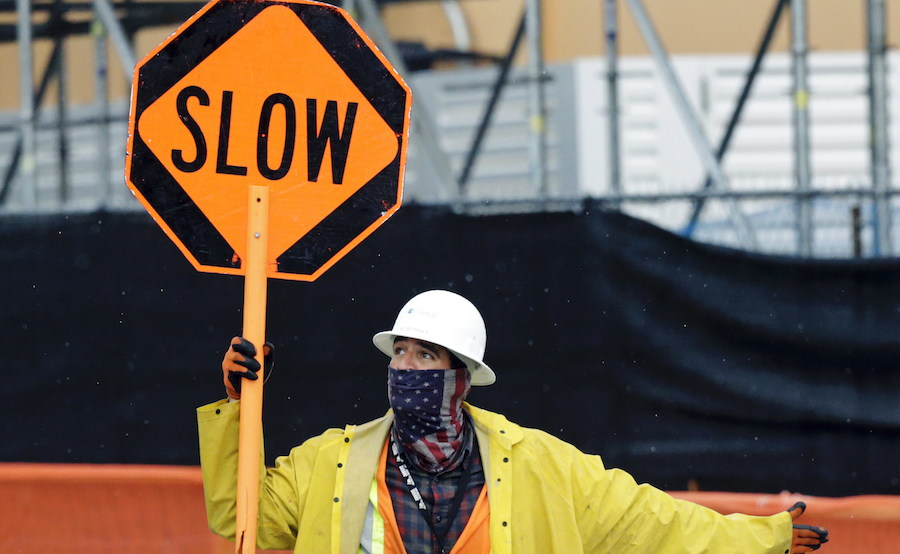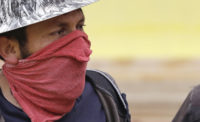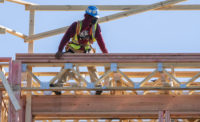Coronavirus and construction masks
Study Claims Popular Face Covering Could Worsen Virus Spread
A bad review for versatile lightweight fleeces, buffs or gaiters

A construction worker directs traffic at Sunny Isles Beach near Miami, Fla., in April. Photo: David Santiago/Miami Herald via AP
A
style of face-covering popular among construction workers—the fabric tubes with elastic ends variously called buffs, gaiters or fleeces—could worsen the spread of coronavirus, says a new Duke University study. Valued for versatility and convenience, the buffs allow workers to drop the covering from their noses and mouths to cool faces, untrap carbon dioxide in exhalations or allow eye protection to defog.
Study authors describe it as a demonstration about how best to measure face-covering effectiveness at low cost. No specific industry use was involved. But the analysis places a lightweight buff, the only one of its kind tested, dead last in limiting virus spread, contending that the fabric actually breaks down heavier droplets into smaller aerosol micro-drops that may travel farther and float in the air longer than heavier droplets.
That actually makes the covering using the thin fabric tested worse than no face covering at all, the authors conclude.
To test the buffs or fleeces, the authors selected one made of a thin polyester and spandex, a product that provides a breathable fabric ideal for keeping cool. But the thin fabric, the Duke team found, transmitted numerous droplets and filtered them into smaller pieces. “That’s primarily why they got through” the protection, Martin C. Fischer, a research professor in the department of chemistry and one of the authors, said by email. By transmitting smaller aerosol micro-drops, the fleece also may send the virus farther than heavier, fasting-falling droplets would travel without a mask.
"We noticed that speaking through some masks (particularly the neck fleece) seemed to disperse the largest droplets into a multitude of smaller droplets, which explains the apparent increase in droplet count relative to no mask in that case," the researchers wrote in the journal Science Advances.
“Considering that smaller particles are airborne longer than large droplets (larger droplets sink faster), the use of such a mask might be counterproductive.”
– Duke University researchers, writing in journal Science Advances
"Considering that smaller particles are airborne longer than large droplets (larger droplets sink faster), the use of such a mask might be counterproductive," they wrote.
The Duke analysis expands the universe of scholarly research on face coverings. It already includes conclusions generated after prior pandemics and other analysis begun during the present coronavirus outbreak.
But the issue is further complicated by the political climate in the U.S., where anti-mask and anti-lockdown sentiment has turned masks into cultural crowbars, observers say.
Cloth coverings had already been targeted as weak links in the protective system because of their need to be washed regularly and because of what some critics said was the danger of transferring virus to faces while adjusting, removing or fidgeting with the masks.
The six-author team that created the study consists of faculty or researchers in Duke's departments of Psychology & Neuroscience, Chemistry, Physics, and Radiology and in its School of Medicine. They used an unusual measuring technique in which a subject wearing a face covering speaks in the direction of an expanded laser beam inside a dark enclosure. A cell phone camera video captures the scattered light as droplets filtered through the covering.
The study team took 14 common face-covering designs and tested them with a single speaker; researchers also tested several types with four different speakers. The mask types ranged from a typical, three-layer surgical mask to valved and unvalved N95 masks and to masks of layered combinations of cotton and polypropylene and ones with pleats.
[For ENR’s latest coverage of the impacts of the COVID-19 pandemic, click here]
During a control trial, the speaker wore no protective mask or covering.
The first 10 seconds of the video serve as a silent baseline. For each test, the speaker said, "Stay healthy, people" five times. In the next 10 seconds, the mask wearer repeated the sentence five times, after which the camera kept recording for an additional 20 seconds. For each mask and for the control trial, this protocol was repeated 10 times.
The team found that the traditional cone-shaped N95 masks, which unlike buffs or gaiters, are rated as personal protective equipment by federal agencies, are most effective in stopping droplet-related spread.
Different types of fleece masks, with different test subjects, could produce different results. “We expect there are variations of performance” and “there are just too many different mask types to test them all,” Fischer says.
The study complicates an already cluttered landscape of virus-related protections for workers and places workers and employers in a difficult position of choosing between effective virus protection and reduced comfort, convenience and productivity, along with added costs.
Masks have been standard at construction jobsites since the pandemic's spread was recognized and because social distancing of six feet at all times is impossible. But actual working conditions are of course different from darkened enclosures under controlled conditions.
The authors did not describe how the volume of the speaker's words during the test was kept constant but did acknowledge that their testing method isn't the same as measuring droplet scatter in an actual work setting.
One concern this summer has been heat. Last month, Matthew Eleazer, president of bricklayers union Local 1, based in Oregon and Washington, said his union and its signatory contractors distributed buffs to union members who perform strenuous work. The masons valued the ability to pull the fabric down while it remained around their necks, allowing a chance to cool off faces.
Other construction employers now recognize that counting on workers to bring their own face covering may not be enough. Earlier this month, Mecklenburg County, N.C., business leaders and government officials started distributing 100,000 face coverings intended to reduce the amount of infection spread among some groups of construction trades workers after positive cases surfaced on projects.
The free masks provided appeared to be variations of the multi-layered, cotton-style types, which scored in the droplet spread study's middle range. Those types were more effective than the buff, according toe the Duke researchers, but less effective than the more-costly N95 masks used to prevent respiratory damage when dust particles are airborne.
This article was updated August 18 to include the input from the study authors and to emphasize that their test of the face-covering fleece (also known as buffs or gaiters) was of a lightweight polyester and spandex variety only.




